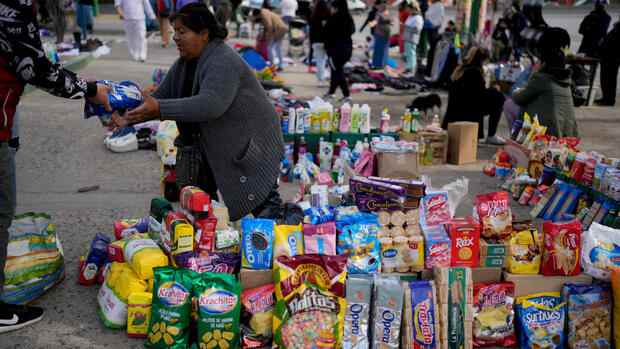Argentina ranks highest in the global inflation list. Due to the enormous price increases for food, dozens of women meet regularly to exchange clothing, toys and kitchen utensils for essentials.
(Photo: AP)
Buenos Aires Consumer prices in Argentina have risen by more than two-thirds, a full 71 percent, over the year. The figures, which the statistics authority Indec has been spreading these days, once again occupy the top position that the South American country occupies in the global list of inflation.
Villa Fiorito on the outskirts of Buenos Aires clearly shows what that means. Every afternoon, Monday through Saturday, women gather here hoping to trade things they can spare for necessities of life. In a square in the birthplace of football legend Diego Maradona, they spread out their blankets and carefully spread out the goods they brought with them: clothes, toys, kitchen utensils. In return they would like to have food for the children.
Dozens of women try to make ends meet with their families every day. They don’t have work and a regular income to at least compensate for the immensely increasing food costs.
The rise in food prices is particularly noticeable. This causes the poverty rate in the country to continue to rise significantly. Around 40 percent of the 47 million Argentines are already affected by poverty.
Top jobs of the day
Find the best jobs now and
be notified by email.
“The money just isn’t enough,” says Soledad Bustos. The 31-year-old comes to Villa Fiorito’s swap market every afternoon while her sister is babysitting one of their children and another is at school. On offer she has jeans, leather boots, sneakers and shirts – bought from her own closet or cheaply used. Your swap request? milk powder. You can’t get that anymore.
“Living from hand to mouth”
The single mother also has other necessities: “I can’t make it to the end of the month.” As an unemployed person, she receives the equivalent of around 250 euros a month from the state, which is not enough to get herself and the little ones through. “Apart from food, I also have to buy things for school and medicine,” says Bustos. “I have no choice but to come here.”
Barter markets had already spread in Argentina after the momentous economic collapse of 2001. Now they are up to date again. “It’s a hand-to-mouth life,” explains María Inés Pereyra, the market coordinator in Villa Fiorito. “Everything they get today, they put directly on the dining table,” she says of the traders.
>> Read here: Has the Inflation peaked? How experts assess the situation in the USA and Europe
For safety reasons, only women are allowed to trade here, and many of the barter deals are also agreed in advance via Facebook or WhatsApp. There are no specifications for the level of the price, but Pereyra has set an upper bar of 300 pesos per item of clothing. That’s the equivalent of almost two euros. A pair of sneakers can be exchanged for a packet of sugar, oil, flour and tea.
No improvement in sight
There is no sign of relaxation. In fact, it looks like the next few months will only get worse. Analysts are forecasting inflation to top 90 percent this year and warn that it could reach triple digits if Alberto Fernández’s government doesn’t curb inflation.
She blames a currency crisis for the accelerated inflation of 7.4 percent in July, triggered by speculation “that should cause uncertainty and lead to a devaluation”. At least that’s what government spokeswoman Gabriela Cerruti said last week.
For August, analysts expect a further price increase similar to that in July. In Villa Fiorito, that hits women like Soledad Bustos hard. They can do little. They focused solely on survival, says Bustos.
More: Inflation in the US is moderating – but pressure on the Fed remains high
